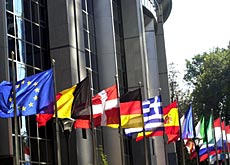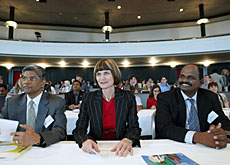Swiss federalism sets example for new Europe

Agreement over a new European constitution, which would effectively turn the continent into a federal state, moved a step closer at last weekend’s European Union summit in Rome.
The European model has similarities with Switzerland’s own federal system.
Last weekend the leaders of the 25 present and future EU members met in the Italian capital to discuss the future policies of the union.
High on the agenda was the draft constitution, drawn up by the European Convention, which was widely accepted. But there are still a few outstanding points that have to be agreed upon.
For example, it is not yet clear whether the executive body will consist of 15 or 25 commissioners all with voting rights.
Other bones of contention include the size of the majority needed to adopt a resolution, and whether the constitution should include a preamble about the Christian roots of the continent.
European republic
Professor Thomas Fleiner at Fribourg University’s Institute for Federalism regards the new European Constitution as the basic tool for the creation of a new state.
“Up until now the EU has had a similar status to an international organisation,” Fleiner told swissinfo.
The future bloc is to have a proper legislative parliament, an executive commission and an independent judiciary.
“The EU is changing from a federation to a confederation,” Fleiner explained.
But Lorenzo Allio, a political scientist at the European Policy Centre in Brussels, does not share Fleiner’s view.
“It might go in this direction; however, there is still a long way to go,” he told swissinfo.
Role model
In 1848 the cantons of Switzerland created a constitution and a central government, and set the foundation stone for federalist Switzerland.
But are there any parallels with the EU? And has the Alpine nation made a mark on the new Europe?
“You can’t really say that,” replied Fleiner. “But I am sure the draft of the constitution is based on existing models, including Swiss models that have existed for 150 years.”
The draft also includes the principle to respect minorities and different communities – an important element of the Swiss constitution.
The way the new federal Europe is due to work is also very similar to the system used in Switzerland.
Participation
For the more than 450 million inhabitants of the 25 member countries, the right to launch popular initiatives will be revolutionary. However, Fleiner thinks the EU is still a long way away from the Swiss model.
Many European countries are only familiar with the system of representative democracy, where citizens delegate authority to elected representatives.
The population only goes to the polls in times of elections and hardly ever vote on referendums.
“The new right to launch initiatives is still limited, but it is still a revolution for those countries which do not give their people the right to participate in the passing of new legislation,” Allio told swissinfo.
Future Europe
The new Europe will have a president, a foreign minister and a coordinated defence system, and the European Central Bank will have the power to steer the union’s economy.
And even though all decision-making processes will be controlled by a constitutional court, the new Europe will not be a single state.
“The draft of the constitution does not mention the word federalism, which could be partly due to the fact that many EU member states, such as Britain and France, are not in favour of a federalist state.”
Arguments continue to rage and every member country is still trying to fight its own corner. However, to use the words of the German chancellor, Gerhard Schröder, nations should trust “the power of reason”.
The meeting in Rome brought the EU nearer to agreement on its new constitution, which is due to come into force next year.
However, the EU is still a long way away from turning into the United States of Europe or into the “European Confederation”.
swissinfo, Daniele Papacella (translation: Billi Bierling)
After one year of debating, the European Convention presented a draft of a new constitution to the European Commission in the Italian capital, Rome.
The aim is to create uniform structures to facilitate the EU expansion in 2004.
The Convention brought together representatives of national governments and the European Parliament.
The draft envisages a central government for the union and the gradual transition of the EU into a confederation.
The European Union is due to sign the Rome Constitution on May 9 next year.

In compliance with the JTI standards
More: SWI swissinfo.ch certified by the Journalism Trust Initiative










You can find an overview of ongoing debates with our journalists here . Please join us!
If you want to start a conversation about a topic raised in this article or want to report factual errors, email us at english@swissinfo.ch.